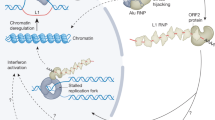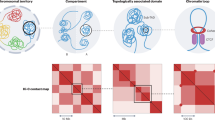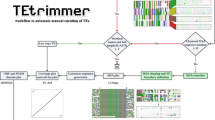Abstract
Mobile genetic elements have been reported in prokaryotes, plants, yeast and Drosophila (reviewed in refs 1, 2). The only transposonlike sequences reported for mammalian organisms are closely related to retroviruses3–7, although undoubtedly other transposon families exist within the mammalian genome. Although mobile genetic elements can only be identified as such if their mobility can be demonstrated in existing populations, transposon and transposon-like elements share several common biochemical and structural features1,2. Here we demonstrate that a repetitive human sequence has many of the diagnostic features of transposable elements. This 2.3-kilobase (kb) transposon-like element contains two flanking long terminal repeat (LTR)-like 350-base pair (bp) repetitive sequences, each of which begins with the sequence 5′ TG… and ends with …CA 3′. The transposon-like element is bounded by 5-bp direct repeats. Discrete-length polyadenylated transcripts from HeLa cells are homologous to the transposon-like element. Members of this transposon-like family are found in extrachromosomal circular DNA molecules.
This is a preview of subscription content, access via your institution
Access options
Subscribe to this journal
Receive 51 print issues and online access
$199.00 per year
only $3.90 per issue
Buy this article
- Purchase on SpringerLink
- Instant access to full article PDF
Prices may be subject to local taxes which are calculated during checkout
Similar content being viewed by others
References
Flavell, A. J. & Ish-Horowicz, D. Nature 292, 591–595 (1981).
Temin, H. M. Cell 21, 599–600; 27, 1–3 (1980).
Varmus, H. E. Science 216, 812–820 (1982).
Schmidt, M., Gloggler, K., Wirth, T. & Horak, I. Proc. natn. Acad. Sci. U.S.A. 81, 6696–6700 (1984).
Streck, R. E. Nature 298, 767–769 (1982).
Kuff, E. L. et al. Proc. natn. Acad. Sci. U.S.A. 80, 1992–1996 (1983).
Mager, D. L. & Henthorn, P. J. Proc. natn. Acad. Sci. U.S.A. 81, 7510–7514 (1984).
Sun, L., Paulson, K. E., Schmid, C. W., Kadyk, L. & Leinwand, L. Nucleic Acids Res. 12, 2669–2690 (1984).
Elder, R. T., Loh, E. Y. & Davis, R. W. Proc. natn. Acad. Sci. U.S.A. 80, 2432–2436 (1983).
Flavell, A. J., Levis, R., Simon, M. A. & Rubin, G. M. Nucleic Acids Res. 9, 6279–6291 (1981).
Rose, A. M. & Snutch, T. P. Nature 311, 485–486 (1984).
Krolewski, J. J. & Rush, M. G. J. molec. Biol 174, 31–40 (1984).
Schindler, C. W. & Rush, M. G. J. molec. Biol. (in the press).
Schmid, C. W. & Jelinek, W. R. Science 216, 1065–1070 (1982).
Singer, M. F., Thayer, R. E., Grimaldi, G., Leeman, M. I. & Fanning, T. G. Nucleic Acids Res. 11, 5739–5745 (1983).
Author information
Authors and Affiliations
Rights and permissions
About this article
Cite this article
Paulson, K., Deka, N., Schmid, C. et al. A transposon-like element in human DNA. Nature 316, 359–361 (1985). https://doi.org/10.1038/316359a0
Received:
Accepted:
Issue date:
DOI: https://doi.org/10.1038/316359a0
This article is cited by
-
Circular DNA elements of chromosomal origin are common in healthy human somatic tissue
Nature Communications (2018)
-
Phylogenetic relationships among transposon-like elements in human and primate DNA
Journal of Molecular Evolution (1995)
-
Evolution and biological significance of human retroelements
Virus Genes (1995)
-
Isolation and characterization of a DNA fragment containing various kinds of repetitive sequences located on human chromosome 21
Japanese Journal of Human Genetics (1993)
-
Expressed genes, Alu repeats and polymorphisms in cosmids sequenced from chromosome 4p16.3
Nature Genetics (1992)



